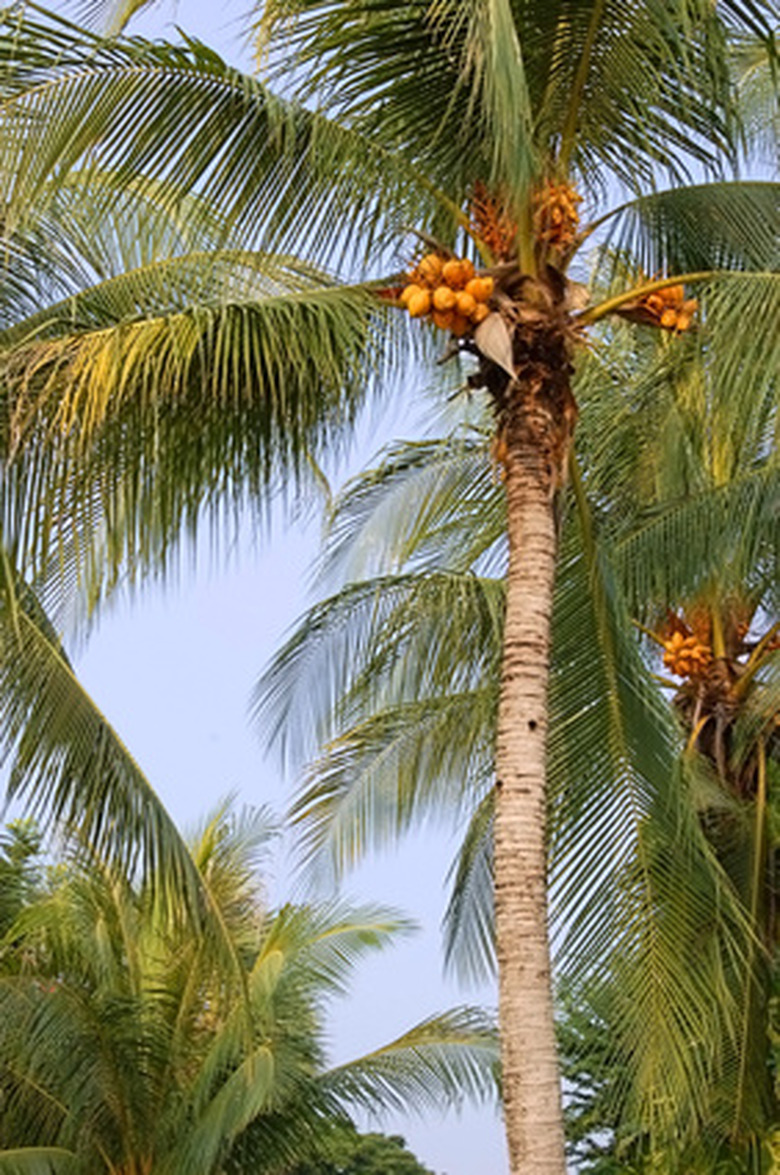How Long Do Palm Trees Live?
Palm trees grow in tropical regions and can achieve great heights and live long lives. Belonging to the Palmae or Arecaceae plant family, over 2,500 species of palms are known to exist. A typical palm tree has a tall, slender trunk with no lateral branches. The leaves, or fronds, grow only from the treetop. Because many palms have slender trunks and live close to coastal areas, they can be killed if toppled by hurricanes and other inclement weather.
Types of Palm Trees
Common palm species include the coconut palm, which grows in tropical regions around the world and provides not only food but also fiber, building materials and shade. It is believed that the first coconut palm originated in Malaysia and quickly spread around the globe. Date palms come from Africa and nearby areas and belong to the genus Phoenix. They provide a sweet fruit called the date, which is used in confections and other recipes in many countries. The graceful areca palm has many branches and is often used as a houseplant. Oil palms produce an oil that is extracted from their fruits.
- Palm trees grow in tropical regions and can achieve great heights and live long lives.
- Common palm species include the coconut palm, which grows in tropical regions around the world and provides not only food but also fiber, building materials and shade.
Coconut Palms
Assuming the coconut palm is not purposely cut down or blown over in severe weather, this tropical tree can live for 80 to 90 years, according to Union County College in New Jersey. Its botanical name is Cocos nucifera and it can attain a height of 100 feet at maturity. The fruit, or "nut," gives us the ingredient known as coconut, which is used in confections and other dishes around the world. The meat is nutritious, and contains as much protein as 1/4 lb. of steak.
Date Palms
Several species of date palms are cultivated in tropical countries such as those on the African continent and provide the sweet, chewy fruit known as the date. According to the United Nations Food and Agriculture Organization, date palms can live 100 years, although their productive life is limited to the years when the tree is smaller and the fruit is easier to reach for harvest. These palms can reach 75 feet in height at maturity, but are frequently cut down when they are about 45 feet tall or when their productivity declines.
- Assuming the coconut palm is not purposely cut down or blown over in severe weather, this tropical tree can live for 80 to 90 years, according to Union County College in New Jersey.
- According to the United Nations Food and Agriculture Organization, date palms can live 100 years, although their productive life is limited to the years when the tree is smaller and the fruit is easier to reach for harvest.
Areca Palms
The areca palm, or Dypsis lutescens, is native to Madagascar and reaches an adult height of 30 feet. It does well as a potted specimen and is often used as a houseplant. It's tolerant of dry weather and salty seaside conditions. The areca palm has a relatively short lifespan compared with other palms and usually lives until its 40th birthday.
Oil Palms
Several species of palms are cultivated commercially for their oil. Indonesia is a major producer of palm oil, producing about 20 million metric tons of this commodity each year since 2007. The oil palms grown in Indonesia are the Tenera hybrid variety, which is a cross between the Dura and Pisifera oil palm trees. Fruit is harvested until they are about 25 years old or 25 feet tall. The best harvests occur when the tree is between 8 and 15 years old. Trees are felled when they reach 25 feet because the tools used to pick the fruit cannot reach higher. If left to grow, these trees can grow up to 100 feet tall and live significantly longer than 25 years.
- The areca palm, or Dypsis lutescens, is native to Madagascar and reaches an adult height of 30 feet.
- Trees are felled when they reach 25 feet because the tools used to pick the fruit cannot reach higher.
